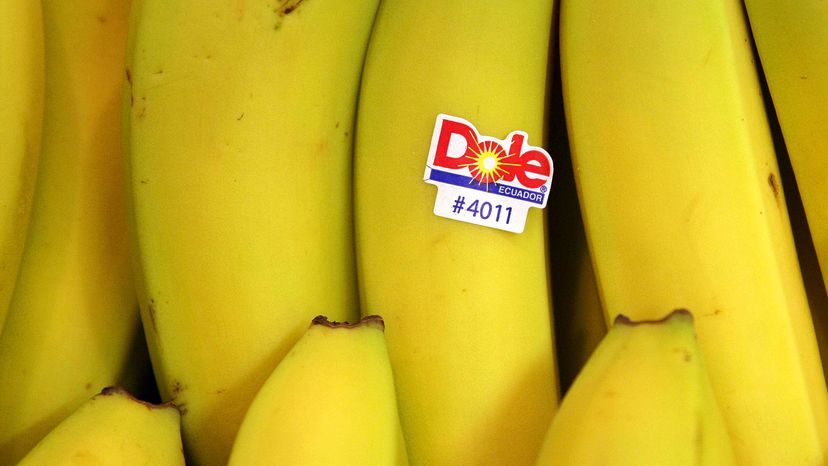 “The sticker on this bunch of bananas shows the country of origin plus lets a cashier know that it is conventionally grown (not organic) and to charge accordingly. Justin Sullivan/Getty Images
“The sticker on this bunch of bananas shows the country of origin plus lets a cashier know that it is conventionally grown (not organic) and to charge accordingly. Justin Sullivan/Getty Images
Whenever you grab an apple and prepare to bite into it, you’ve probably noticed a little sticker attached to the fruit with a row of four or five numbers on it.
That string of digits is something called a PLU, or Price Look-Up code, and its function is fairly simple. It’s designed to help supermarkets identify their inventory of fruits and vegetables, and to make it easy for checkout clerks to know what to charge for a particular item, so that you can get through the line and out the door more efficiently.
But that little number also can tell you what specific variety of a particular fruit or vegetable you’re going to enjoy — whether it’s a Honeycrisp apple or a Shamouti orange, for example — and whether it was grown conventionally or on an organic farm that doesn’t use chemical fertilizers and pesticides. The code may also tell you the size of the fruit or vegetable, from small to extra-large.
PLU codes are assigned to particular types of fruit and vegetables by the International Federation for Produce Standards (IFPS), a global organization whose mission is to make sure the supply chain for the fresh produce industry works efficiently.
"PLU numbers indicate the commodity, variety and growing method (conventional and organic) at the point of sale to enable the retailer to charge the correct price for the product," Ed Treacy, vice president of supply chain and sustainability for the Produce Marketing Association, explains via email.
PLU codes can be used two different ways in checkout lines, according to Treacy. "The four or five-digit number can be manually eyed into the cash register or if the PLU sticker has a databar barcode on it, that barcode can be scanned which will be mapped to the corresponding PLU code," he says.
The Reason for PLU Codes
A PMA volunteer committee developed price lookup codes back in 1988. One important reason for PLUs was to enable supermarkets to tell the difference between conventionally grown fruits and vegetables and higher-priced organic food.
"Organic produce was being introduced by retailers then and they were paying a premium for organic, and their cashiers were selling it at the conventional price," Treacy says. "A conventionally grown fruit or vegetable looks the same as an organic fruit or vegetable."
To solve that problem, the industry came up with a system in which conventionally grown produce items are assigned four-digit numbers in the 3000 and 4000 range. If a fruit or vegetable is raised organically, it gets a prefix of 9 placed in front of the usual code for that item, according to an article on the PMA website. The PMA adds that the codes "are not intended to convey information to consumers. They are simply business tools for accurate price rings at the cash register, inventory control and category management." Also, the numbers inside these four-digit codes are randomly assigned.
every cashier always knows the banana plu code first #easiest #4011 @Cashier_Issues
— teresa maria (@teresadoughten) September 18, 2012
There are now more than 1,500 different PLUs in use around the globe. If you want to know what a particular one means, IFPS offers this web-based PLU search app. Just type in the code from a sticker on a piece of fruit, and it will tell you that 3114, for example, signifies an extra-large green mango, botanical name Magnifera indica, belonging to the Keitt or Francis varieties of that fruit.
The PLU system enables retailers to tell the difference between 80 or so different varieties of apples, as well as between smaller and bigger versions of some varieties, from small Akane applies (4098) to large Fuji apples (4131), as well as Honeycrisp (3283), Rubinette (3008) and Virginia Gold (3271). Jerusalem artichokes (4791), baby sweet corn (4589), red leaf lettuce (4075), five different types of watermelons, 16 different varieties of oranges and 35 different types of pears also have their own numbers in the system.
To get a sense of the diverse assortment of fruits and vegetables available in supermarkets, see this list of PLU codes. Companies can request that new PLU codes for produce varieties be added to the list by applying to the IFPS board.
The Future of Fruit and Vegetable Stickers
If you separate your food waste to go to a composting facility, it’s important to remove the stickers before you throw banana peels or other discarded parts of fruit, so that the stickers don’t contaminate the process. Indeed, France actually is imposing a ban on identifying stickers on produce in 2022 for that reason, which may turn into a problem for American agricultural exporters, the U.S. Department of Agriculture reports.
The produce industry has been trying to develop biodegradable PLU stickers, but it’s difficult to find an adhesive that’s sticky enough to stay on a piece of fruit through the entire food chain and then dissolve afterward, according to The New York Times. Eventually, PLU stickers may be replaced altogether by lasers that etch the codes into fruits and vegetables.
Now That’s Interesting
The U.S. Food and Drug Administration regulates the chemicals and materials used in any sort of label attached to food to ensure that they don’t pose a safety risk. Even so, you don’t want to eat them, since they have no flavor or nutritional value, as this 2021 New York Times article notes.































